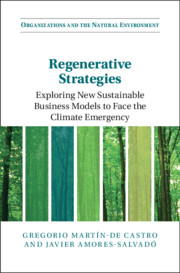Book contents
- Regenerative Strategies
- Organizations and the Natural Environment
- Regenerative Strategies
- Copyright page
- Contents
- Figures
- Tables
- Foreword: Reversing Course
- Acknowledgements
- 1 Introduction
- 2 Assessing the Response to the Climate Grand Challenge
- 3 Business as Usual
- 4 Sustainable Business Models
- 5 Climate Emergency in the Anthropocentric Era
- 6 The Regenerative Strategy
- 7 The Regenerative Strategy
- 8 Concluding Remarks
- Index
- References
7 - The Regenerative Strategy
Facing the Climate Emergency
Published online by Cambridge University Press: 28 March 2024
- Regenerative Strategies
- Organizations and the Natural Environment
- Regenerative Strategies
- Copyright page
- Contents
- Figures
- Tables
- Foreword: Reversing Course
- Acknowledgements
- 1 Introduction
- 2 Assessing the Response to the Climate Grand Challenge
- 3 Business as Usual
- 4 Sustainable Business Models
- 5 Climate Emergency in the Anthropocentric Era
- 6 The Regenerative Strategy
- 7 The Regenerative Strategy
- 8 Concluding Remarks
- Index
- References
Summary
This chapter illustrates how to put a regenerative strategy into action by introducing a pioneering business case. The company Carbon Engineering is developing cutting-edge technologies, such as Direct Air Capture and AIR TO FUELS, to capture, sequester and, more importantly, apply captured carbon dioxide in the production of synthetic fuel, carrying out a regenerative strategy. Through a qualitative research design, we show how this company (1) demonstrates explorer and prospector behaviour, going beyond the reduction of emissions to achieve net zero and even net negative emissions, or positive environmental externalities; (2) redefines its purpose, vision and mission, passing from a profit-only logic to systemic socioecological resilience through eco-emotional wealth and environmental performance; (3) develops a new, wider form of stakeholder management to engage market and fringe stakeholders; and finally (4) frames a new time perspective, the long- and very long-term view that sustainable development requires – an intra- and intergenerational commitment.
Keywords
- Type
- Chapter
- Information
- Regenerative StrategiesExploring New Sustainable Business Models to Face the Climate Emergency, pp. 179 - 222Publisher: Cambridge University PressPrint publication year: 2024



